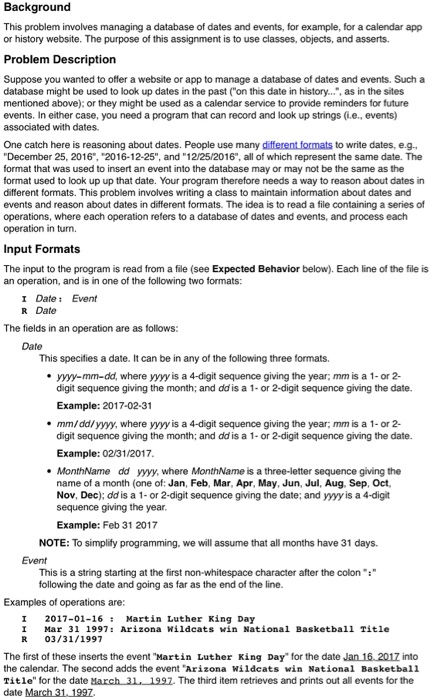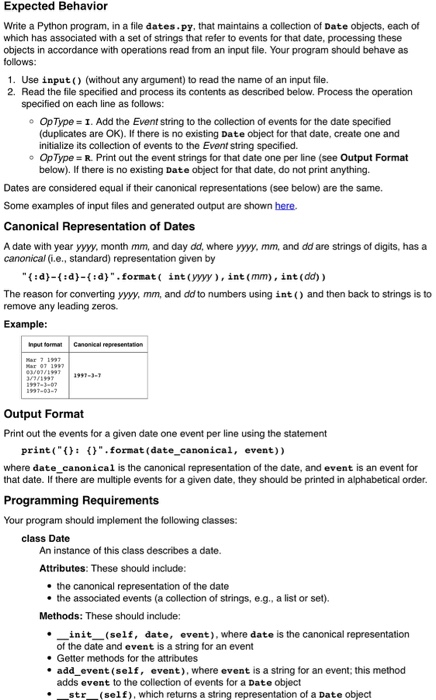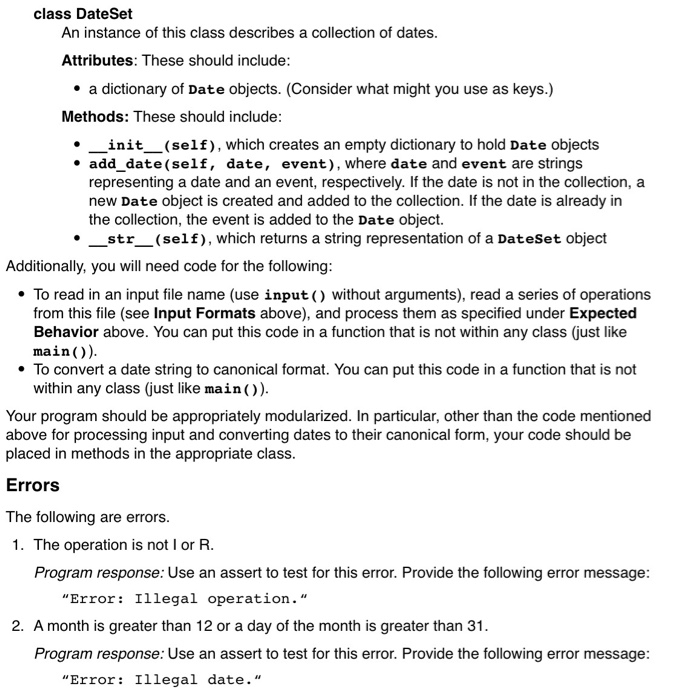Could someone please help me write the following code in Python? Please include code commenting so I can learn what is happening. Thank you. :)
Background This problem involves managing a database of dates and events, for example, for a calendar app or history website. The purpose of this assignment is to use classes, objects, and asserts. Problem Description Suppose you wanted to offer a website or app to manage a database of dates and events. Such a database might be used to look up dates in the past ("on this date in history..", as in the sites mentioned above); or they might be used as a calendar service to provide reminders for future events. In either case, you need a program that can record and look up strings (i.e., events) associated with dates. One catch here is reasoning about dates. People use many different formats to write dates, e.g. December 25, 2016", "2016-12-25", and "12/25/2016", all of which represent the same date. The format that was used to insert an event into the database may or may not be the same as the format used to look up up that date. Your program therefore needs a way to reason about dates in different formats. This problem involves writing a class to maintain information about dates and events and reason about dates in different formats. The idea is to read a file containing a series of operations, where each operation refers to a database of dates and events, and process each operation in turn. Input Formats The input to the program is read from a file (see Expected Behavior below). Each line of the file is an operation, and is in one of the following two formats: I Date: Event R Date The fields in an operation are as follows: Date This specifies a date. It can be in any of the following three formats. yyyy-mm-dd, where yyyy is a 4-digit sequence giving the year; mm is a 1- or 2- digit sequence giving the month; and dd is a 1- or 2-digit sequence giving the date. Example: 2017-02-31 mm/dd/yyyy, where yyyy is a 4-digit sequence giving the year; mm is a 1- or 2- digit sequence giving the month; and dd is a 1- or 2-digit sequence giving the date. Example: 02/31/2017 e MonthName dd yyyy, where MonthName is a three-letter sequence giving the name of a month (one of: Jan, Feb, Mar, Apr, May, Jun, Jul, Aug, Sep, Oct, Nov, Dec); dd is a 1- or 2-digit sequence giving the date; and yyyy is a 4-digit sequence giving the year Example: Feb 31 2017 NOTE: To simplify programming, we will assume that all months have 31 days. Event This is a string starting at the first non-whitespace character after the colon following the date and going as far as the end of the line. Examples of operations are: I 2017-01-16 Martin Luther King Day I Mar 31 1997: Arizona Wildcats win National Basketball Title R 03/31/1997 The first of these inserts the event "Martin Luther King Day" for the date Jan 16.201Z into the calerndar. The second adds the event "Arizona Wildcats win National Basketball Title" for the date March 31 1997. The third item retrieves and prints out al events for the date March 31. 1997 Expected Behavior Write a Python program, in a file dates.py, that maintains a collection of Date objects, each of which has associated with a set of strings that refer to events for that date, processing these objects in accordance with operations read from an input file. Your program should behave as follows: 1. Use input) (without any argument) to read the name of an input file. 2. Read the file specified and process its contents as described below. Process the operation specified on each line as follows OpType (duplicates are OK). If there is no existing Date object for that date, create one and initialize its collection of events to the Event string specified. I. Add the Event string to the collection of events for the date specified o Op Type-R. Print out the event strings for that date one per line (see Output Format below). If there is no existing Date object for that date, do not print anything. Dates are considered equal if their canonical representations (see below) are the same. Some examples of input files and generated output are shown here. Canonical Representation of Dates A date with year yyyy, month mm, and day dd, where yyyy, mm, and dd are strings of digits, has a canonical (i.e., standard) representation given by "(.d)-{:4)-d)', . format ( int (yyyy ), int (mm), int (dd) ) The reason for converting yyyy, mm, and dd to numbers using int) and then back to strings is to remove any leading zeros. Example 997-3-0 Output Format Print out the events for a given date one event per line using the statement print") ".format (date canonical, event)) where date canonical is the canonical representation of the date, and event is an event for that date. If there are multiple events for a given date, they should be printed in alphabetical order Programming Requirements Your program should implement the following classes: class Date An instance of this class describes a date. Attributes: These should include e the canonical representation of the date e the associated events (a collection of strings, e.g., a list or set). Methods: These should include: .init (self, date, event). where date is the canonical representation of the date and event is a string for an event . Getter methods for the attributes add event (self, event), where event is a string for an event; this method adds event to the collection of events for a Date object str(self), which returns a string representation of a Date object class DateSet An instance of this class describes a collection of dates Attributes: These should include e a dictionary of Date objects. (Consider what might you use as keys.) Methods: These should include . init (self), which creates an empty dictionary to hold Date objects e add_date (self, date, event), where date and event are strings representing a date and an event, respectively. If the date is not in the collection, a new Date object is created and added to the collection. If the date is already in the collection, the event is added to the Date object. str_(self), which returns a string representation of a DateSet object Additionally yo need code for the following * To read in an input file name (use input() without arguments), read a series of operations from this file (see Input Formats above), and process them as specified under Expected Behavior above. You can put this code in a function that is not within any class (just like main()) * To convert a date string to canonical format. You can put this code in a function that is not within any class (just like main()) Your program should be appropriately modularized. In particular, other than the code mentioned above for processing input and converting dates to their canonical form, your code should be placed in methods in the appropriate class Errors The following are errors 1. The operation is not l or R Program response: Use an assert to test for this error. Provide the following error message "Error: Illegal operation.'" 2. A month is greater than 12 or a day of the month is greater than 31 Program response: Use an assert to test for this error. Provide the following error message "Error: Illegal date









